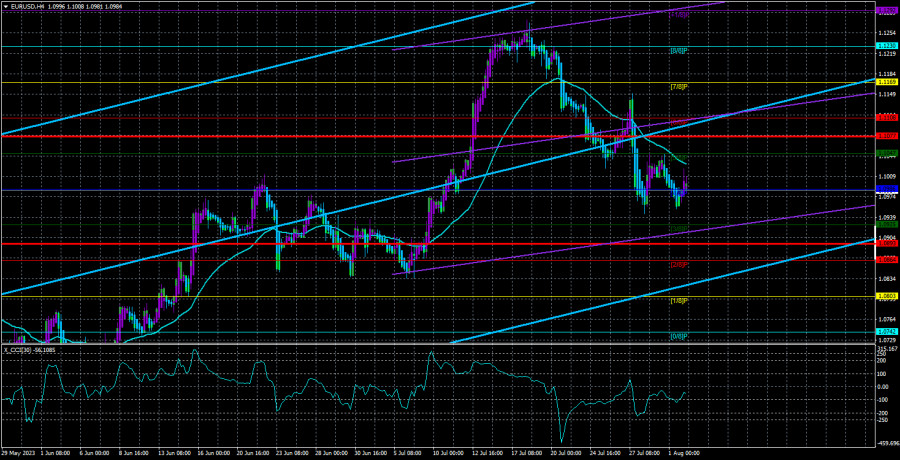

On Tuesday, the EUR/USD currency pair experienced a minor upward correction, but the volatility was extremely low, making this movement insignificant. The price is still below the moving average line, suggesting a potential resumption of its downward movement at any time. We have emphasized that the euro has surged considerably and undeservedly in the past ten months, leading to an overbought situation. Consequently, irrespective of the fundamental and macroeconomic backdrop, we anticipate the pair to decline in the next few months.
It is important to remember that the dollar's decline began last fall when US inflation started to slow down. This indicates that the market had already factored in all the Federal Reserve rate hikes and subsequently adjusted expectations for similar increases from the European Central Bank. The European regulator is giving clear signals of either a pause or the conclusion of its tightening cycle. Thus, buying the euro currency seems pointless at this stage.
For the dollar in 2023, there is only one potential risk. Inflation has already dropped to 3%, which might prompt the Federal Reserve to hint at a softer monetary policy in 2024. Such news could lead to renewed selling of the American currency. A similar scenario might occur for the European Central Bank, placing pressure on the euro currency. However, until these circumstances materialize, the euro currency should continue to trend towards the 5-6 levels.
The US labor market acts as a starting point for the dollar.
To put it plainly, the start of the week for the EUR/USD pair has been uneventful, contrary to our expectations based on the events calendar for this week. Reports on GDP and inflation in the European Union were released on Monday. At the same time, Tuesday saw the release of the ISM index for the manufacturing sector and the JOLTs report on job openings in the US. However, all four reports showed values that can hardly be considered significant. They closely aligned with the forecasts, resulting in a weak market reaction, if any. Today, there are no important reports. We do not consider the ADP report since it does not match its "brother," Nonfarm Payrolls, in terms of significance.
Consequently, this week, the Bank of England meeting, the ISM index for the services sector, and the Nonfarm Payrolls and unemployment reports are the only significant events. The Bank of England meeting does not directly relate to the dollar or the euro currency, but the British pound's performance can influence both the upside and downside of the euro, as seen in the past. The market might disregard the ISM index if its value mirrors the lackluster nature of the earlier reports this week. Only the Nonfarm Payrolls and unemployment reports have the potential to provoke a reaction in almost any scenario. However, if we observe similar lackluster values in those reports, any volatility spike would be short-lived and limited.
This week has been peculiar - many important reports and events, yet the pair display extremely low volatility. The euro currency continues to slide down and has fallen below the critical line on the 24-hour timeframe. We still maintain that the nearest target is the Senkou Span B line, which is 1.0860, signifying another 140 points downward. We also anticipate a strong correction on the daily timeframe or a new downward trend on the 4-hour timeframe. The euro still appears excessively overbought.
As of August 2nd, the average volatility of the EUR/USD currency pair over the last five trading days is 92 points, categorized as "average." Nevertheless, this level of volatility was primarily influenced by trading last Thursday (184 pips). In the coming days, it may decrease. Consequently, we expect the pair to move between 1.0893 and 1.1077 on Wednesday. A downward reversal of the Heiken Ashi indicator will signal a resumption of the downward movement.
Nearest support levels:
S1 - 1.0986
S2 - 1.0925
S3 - 1.0864
Nearest resistance levels:
R1 - 1.1047
R2 - 1.1108
R3 - 1.1169
Trading recommendations:
The EUR/USD pair continues to remain below the moving average. New short positions can be considered with targets at 1.0925 and 1.0893 in case of a Heiken Ashi indicator reversal to the downside. Long positions will become relevant only if the price firmly establishes above the moving average line, with targets at 1.1077 and 1.1108.
Explanations for the illustrations:
Linear regression channels - help determine the current trend. It indicates a strong current trend if both are directed in the same direction.
Moving average line (settings 20.0, smoothed) - identifies the short-term trend and the direction for trading.
Murray levels - target levels for movements and corrections.
Volatility levels (red lines) - the probable price channel in which the pair will likely move in the next 24 hours, based on current volatility indicators.
CCI indicator - its entry into the overbought area (above +250) or oversold area (below -250) signals an impending trend reversal in the opposite direction.